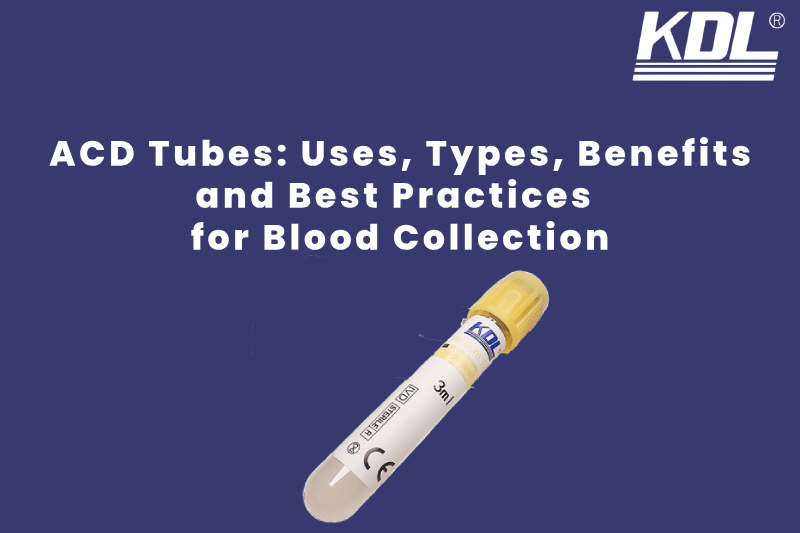
When it cum to blood collection for testing and research, the right hand tools can make all the difference. One important tool that often comes up in clinical and laboratory settings is the ACD tube. These tubes are specially designed for collecting blood while preserving specific components for testing. In this article, we ’ll take a closer looking at what ACD tubes are, their uses, the unlike types available, benefits, and the best practices for using them effectively.
What Are ACD Tubes?
ACD stands for Acid Citrate Dextrose. ACD tubes are a type of blood collection tube that contain this solution to help preserve whole blood samples furthermore they prevent clotting by binding calcium, which is necessary for blood to clot. The dextrose component helps keep red blood cells healthy and viable for longer periods.
These tubes are typically yellow – topped and are used when it ’s important to maintain cellular integrity over time — like in certain types of testing, genetic studies, and transfusion research.
Uses of ACD Tubes
ACD tube are n’t used for general-general blood work like a complete blood count (CBC) or basic metabolic panel. Instead, they ’re reserved for specialized purposes.
1. DNA and Genetic Testing
One of the most, most common uses of ACD vacuum tube is for DNA analysis. Because the ACD solution preserves white blood cells well, it allows for better extraction of high – quality DNA. This is crucial for tests like:
- Genetic mapping
- Ancestry testing
- Paternity testing
- Molecular diagnostics
2. HLA Typing
It could be that, when it comes to HLA, hLA (Human Leukocyte Antigen) typing is often performed when preparing for organ or bone marrow transplants. ACD tubes help preserve the cells needed for accurate typing, which is vital for matching donors with recipients.
3. Tissue Typing and Immunology Tests
Because the ACD solution maintains cell integrity, these tubes are also ideal for tissue typing and other immunological studies. plus, researchers can analyze how immune cadre respond or behave, which is important in developing therapies and understanding disease mechanisms.
4. Blood Banking and Transfusion Medicine
In blood banks, ACD tubes are used to preserve whole blood for sealed types of testing also they ’re literally especially useful when studying red cell antigens or doing compatibility testing over extended periods.
Types of ACD Tubes
There are two main types of ACD thermionic tube, . And it ’s important to know the difference when selecting the right wing one for a test or procedure.
1. ACD Solution A
Contents: 22. 0 g / L trisodium citrate, 8. 0 g / L citric acid, and 24. 5 g / L dextrose.
- Use: Most commonly used for DNA testing and immunohematology.
- Purpose: Offers stronger anticoagulant properties, better preservation for white blood cell.
2. ACD Solution B
Contents: 13. 2 g / L trisodium citrate, 4. 8 g / L citric acid, and 14. 7 g / L dextrose.
- Use: Preferred for certain types of tissue compatibility prove.
- Purpose: Slightly lower concentration allows for different balance of preservation.
Important: Make sure to use the type of tube specified by the test protocol. Using the wrong one could affect the accuracy of the results.
Benefits of ACD Tubes
ACD tubes offer several unique benefits that make them suitable for specific types of blood collection and analysis.
1. Extend Preservation of Blood Cells
Unlike other anticoagulant lab tubes, ACD tubes can preserve blood cells, particularly hmm white blood cells, for a longer period moreover this is critical for DNA extraction, tissue typing, and cell – based studies.
2. Improved DNA Yield and Quality
The solution in ACD tubes protects whiteness blood cells, which are a primary source of DNA. This results in higher DNA yields and wagerer honor, essential for accurate genetic testing.
3. Minimal Interference with Testing
ACD solution does n’t interfere with most molecular or immunologic assays, making it a preferred choice for research labs and diagnostic centers.
4. Safe and Sterile Collection
These tubes are manufactured under sterile conditions. And are easy to use in both clinical and field environments. This helps maintain sample integrity from collection to analysis.
5. Widely Available for Purchase
Many labs and clinics search for yellow top ACD blood tubes for sale, and they’re readily available from ACD blood collection tube manufacturers and medical supply stores online.
Best Practices for Using ACD Tubes
Using ACD tubes properly is key to ensuring the accuracy of test results. Follow these best practices to get the most out of every sample.
1. Follow the Draw Order
Always follow the sequence of draw when taking more than one blood sample. ACD tubes usually come after EDTA tubes and before fluoride tubes. This prevents additives from other tubes from getting into the ACD tube, which might change how well it works.
2. Mix well but gently
After you collect the blood, gently turn the tube upside down 8 to 10 times to mix the blood with the anticoagulant. Don’t shake, since this might damage cells or induce hemolysis.
3. Pick the Right Tube Size
There are many sizes of ACD tubes, such 6 mL and 8.5 mL. Always use the right size for the test. If you fill it too much or too little, the ratio of additives to blood might change, which can change the outcomes.
4. Label Tubes Immediately
It is very important to label things correctly. Add the patient’s name, birth date, time of collection, and any additional information that is needed. Putting the wrong label on anything might cause confusion or provide false results.
5. Store Samples Properly
Depending on the test, most blood that has been preserved with ACD should be kept at room temperature or in the fridge (2–8°C). Don’t ever freeze full blood unless you’re told to, since it may kill cells.
6. Transport Carefully
If you have to send samples to a lab, make sure they are packed well and maintained at the right temperature. Some exams have set time limits, so it’s crucial to get them there on time.
Comparing ACD Tubes with Other Blood Collection Tubes
| Tube Type | Additive | Common Uses | Cell Preservation | DNA Quality |
|---|---|---|---|---|
| ACD Tube | Acid Citrate Dextrose | DNA testing, HLA typing, tissue studies | Excellent | High |
| EDTA Tube | Ethylenediaminetetraacetic Acid | CBC, Hematology | Moderate | Moderate |
| Heparin Tube | Lithium or Sodium Heparin | Chemistry tests | Good | Variable |
| Citrate Tube | Sodium Citrate | Coagulation studies | Poor for DNA | Low |
| Serum Tube | No anticoagulant (with clot activator) | Serum chemistry | Not preserved | Not suitable |
When Not to Use ACD Tubes
While ACD tubes are excellent for many tests, they are not suitable for:
- Routine blood chemistry panels
- Coagulation studies
- Electrolyte measurements
- Blood cultures
For these tests, use the appropriate collection tubes as recommended by the testing laboratory.
Common Mistakes to Avoid When Use ACD Tubes
Even healthcare workers who have been doing it for a long time might make errors using ACD tubes. Some mistakes that happen a lot are:
- Using the incorrect type (A vs. B) might change the results of the test.
- Blood volume that isn’t right: If you have too much or too little blood, it might mess with the anticoagulant balance.
- Not mixing well: This causes samples to coagulate and become useless.
- Bad storage conditions might damage the cells and spoil the test.
Final Thoughts
ACD tubes are very important for keeping blood samples safe for particular tests, especially when it comes to DNA analysis, tissue type, and immunological research. Knowing the difference between ACD Solution A and B and how to properly handle and store them may make your results much more reliable.
You can make sure that each sample is collected, stored, and tested with care and accuracy by following the best practices listed above. ACD tubes are a useful tool in your collection gear, whether you work in a hospital, a research facility, or a blood bank.
 +86-791-8686-1216
+86-791-8686-1216 

